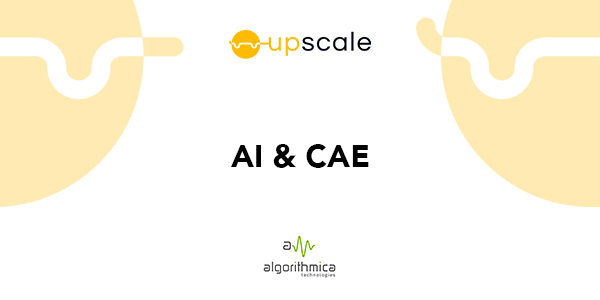UPSCALE is the first EU-project that has the specific goal to integrate artificial intelligence (AI) methods directly into traditional physics-based Computer-Aided Engineering (CAE)-software and –methods.
In this context, algorithmica technologies GmbH is the partner in charge of advising the consortium on machine learning methods, to select the correct tools and parametrize the algorithms in the most effective manner with a view to enhance and speed up electric car production.
Read their answers as experts on machine learning techniques and CAE implementation.
What AI recent developments you deem have applicability to CAE methods?
Recent years have seen many AI developments. Many of these are small incremental improvements upon each other. As such, these developments can be grouped into a few major types. First, there has been a substantial increase in the amount of training data underlying the AI models that are interesting to many applications. Second, the computing hardware is significantly more powerful making it more realistic to train model for longer. Third, mathematicians have discovered ways to accurately train neural networks with more than one hidden layer (deep learning). Fourth, derivatives of the deep learning approach have constructed some models that are good at specific tasks. Examples include the convolutional neural networks good at image recognition and random forests good at categorizing numerical features.
Viewed like this, all four major development have direct useful implications for CAE. The second, third and fourth developments provide the promise that CAE can be assisted by these methods. The major assistance is in automation of CAE activities, respectively in the reduction of the duration of these activities. The first development is a liability for CAE in the sense that the developments require larger datasets for learning, and these must be generated for CAE use cases before the advantages of AI can be reaped. This represents a cost, but it is unavoidable.
As CAE works largely with images, it is especially the image-based processing methods that are applicable, i.e. convolutional neural networks (CNN).
What is the main technological risk of surrogating physics-based methods by data-based methods?
The underlying physical system is governed by a differential equation. We know this, and in many cases, we even know this equation. Solving the equation in any particular instance, however, takes computational resources. Often, these exceed the resources we are prepared to commit to the issue.
Data-based methods allow us to reconstruct the equation from observations in the case that we do not have the equation in the first place. In the cases that we do have the equation, the AI methods produce an approximation to this equation that is far easier to compute. Thus, the benefit lies ultimately in a saving of resources, mostly time.
The risk to be paid for this time saving is in accuracy and precision. The data-based models will reproduce what they have been taught with a certain (and known) accuracy and precision. Moving beyond what they have been taught, these models usually perform significantly worse and we often do not know just how accurate they are in these cases.
The burden upon the researcher is therefore to construct a carefully coordinated training dataset that represents as many cases as possible and contains as many varieties as possible so that the learning can take place fully informed of all possibilities.
In brief, AI methods are “monkey see, monkey do.” They are not intelligent in any human sense as they cannot induce an answer that has not been previously learned.

